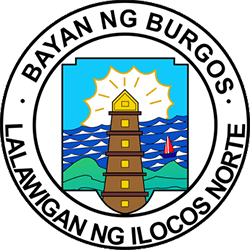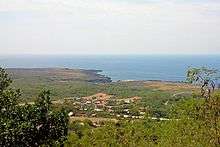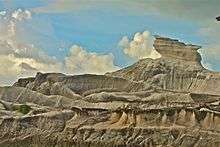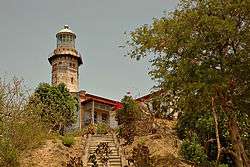Burgos, Ilocos Norte
| Burgos | ||
|---|---|---|
| Municipality | ||
|
Cape Bojeador Lighthouse | ||
| ||
 Map of Ilocos Norte showing the location of Burgos | ||
.svg.png) Burgos Location within the Philippines | ||
| Coordinates: 18°30′58″N 120°38′46″E / 18.51611°N 120.64611°ECoordinates: 18°30′58″N 120°38′46″E / 18.51611°N 120.64611°E | ||
| Country | Philippines | |
| Region | Ilocos (Region I) | |
| Province | Ilocos Norte | |
| District | 1st District | |
| Barangays | 11 | |
| Government[1] | ||
| • Mayor | Crescente N. Garcia | |
| Area[2] | ||
| • Total | 128.90 km2 (49.77 sq mi) | |
| Population (2015)[3] | ||
| • Total | 9,777 | |
| • Density | 76/km2 (200/sq mi) | |
| Time zone | PST (UTC+8) | |
| ZIP code | 2918 | |
| Dialing code | 77 | |
| Income class | 5th class; rural | |
Burgos is a fifth class municipality in the province of Ilocos Norte, Philippines, the most north-western town on the island of Luzon. It was formerly known as Nagpartian[4] and was renamed after the martyred priest José Burgos who was born in the Ilocos Region. According to the 2015 census, it has a population of 9,777 people.[3]
History
The town was first known as Nagparitan, the early inhabitants were called Mumburi and known as a wild and fierce people who prevented the Christianized natives from settling in the vicinity. When the Spaniards came to the area, the people staged a revolt, captured the priest and mutilated his body. Because of this incident, the Spaniards change the name of Nagparitan, meaning prohibit, to Nagpartian which means the place of slaughter.
In 1903, Nagpartian was then fused with the Municipality of Bangui because of the unstable condition due to low collection of government taxes. On February 28, 1914, by virtue of a legislative act, Nagpartian was renamed Burgos in honor of one of the three martyred priest, Fr, Jose Burgos. Seńor Juan Ignacio was the first Presidente Municipal of the town.
Majority of people in the municipality are engaged in the production of commercial crops like rice, garlic, tomato, mongo and corn. However, aside from producing agricultural products, most of them also venture into fishing, livestock and swine-raisin, rice milling, and cottage industries like furniture and hollow-blocks making, smelting, salt-making, and mat weaving.
The town is endowed with scenic and tourist-attracting shores or coastline – from plain white beaches in Barangays. Paayas and Bobon to rugged and sharp cliffs naturally formed through the centuries like Gagamtan Cliff in Barangay Bayog, and Kapur-purawan Cliff in Barangay Saoit. The Digging Falls is another pride of the town, with a beautiful cascade at the boundary of Barangays Ablan and Buduan, certainly a perfect place for local and foreign tourist to spend their summer escapade.
Another worth-mentioning tourist attraction is the historic Cape Bojeador Lighthouse, built during the latter part of the 19th century. Located on a top of a hill overlooking the vast expanse of the China Sea, it serves as a beacon light to passing ships and to local fishermen. Because of its high elevation, it offers travelers with a panoramic view of the rugged coastline of Burgos.
Geography
Barangays
Burgos is politically subdivided into 11 barangays.[2]
- Ablan (Buraan)
- Agaga
- Bayog
- Bobon
- Buduan (Malituek)
- Nagsurot
- Paayas
- Pagali
- Poblacion (Ili)
- Saoit
- Tanap
Area and Location
Burgos is bounded to the north by South China Sea; Bangui in the east and in the south, Pasuquin and Vintar. It has a total land area of 49.77 sq mi. It is situated in the north coast of Ilocos Norte. Burgos has the second largest wind farm in the Philippines.
Local Government
As of the election 2013-2016, these are the elected officials of Burgos:
MAYOR: Cresente N. Garcia
VICE MAYOR: Rey G. Espejo
SBM 1: Rodolfo L. Garcia
SBM 2: Kervin G. Guinto
SBM 3: Cafrialdes M. Guinto
SBM 4: Francis A. Calapini
SBM 5: Marie Jette S. Perez
SBM 6: Almirante R. Espejo
SBM 7: Efren A. Saguiguit
SBM 8: Joseph B. Jimenez
Government Seal

Shield, derived from the Provincial Seal of Ilocos Norte.
Lighthouse, represents the Cape Bojeador Lighthouse, the main tourist attraction in the town.
Light, serves as guide to shipping vessels cruising the China Sea.
Mountain and Sea, depict the geographical location and the territorial limits of the municipality.
Climate
Burgoes has a Tropical savanna climate with warm to hot weather year round.
| Climate data for Burgos (2011) | |||||||||||||
|---|---|---|---|---|---|---|---|---|---|---|---|---|---|
| Month | Jan | Feb | Mar | Apr | May | Jun | Jul | Aug | Sep | Oct | Nov | Dec | Year |
| Average high °C (°F) | 26 (79) |
29 (84) |
30 (86) |
33 (91) |
34 (93) |
34 (93) |
34 (93) |
32 (90) |
32 (90) |
31 (88) |
29 (84) |
27 (81) |
30.9 (87.7) |
| Daily mean °C (°F) | 22 (72) |
23 (73) |
25 (77) |
27 (81) |
29 (84) |
29 (84) |
29 (84) |
28 (82) |
27 (81) |
26 (79) |
25 (77) |
23 (73) |
26.1 (78.9) |
| Average low °C (°F) | 18 (64) |
18 (64) |
20 (68) |
20 (68) |
24 (75) |
24 (75) |
24 (75) |
23 (73) |
22 (72) |
22 (72) |
21 (70) |
19 (66) |
21.3 (70.2) |
| Source: [5] | |||||||||||||
Demographics
| Population census of Burgos | ||
|---|---|---|
| Year | Pop. | ±% p.a. |
| 1990 | 7,643 | — |
| 1995 | 8,227 | +1.39% |
| 2000 | 8,534 | +0.79% |
| 2007 | 8,765 | +0.37% |
| 2010 | 9,687 | +3.71% |
| 2015 | 9,777 | +0.18% |
| Source: National Statistics Office[3][6] | ||
Places of interest
- Burgos Wind Farm is the second and largest wind farm in the Philippines. It started generating electricity on November 9, 2014.
- Cape Bojeador Lighthouse, also known as Burgos Lighthouse, is a cultural heritage structure in Burgos established during the Spanish Colonial times.
- Kapurpurawan Rocks are rock formations created by forces of the ocean on the rocky coast of Burgos, located just a few minutes further from the lighthouse.
- Kaangrian Falls is a multi-tiered stair like formation with the water cascading on every step until it drops to a pool below.
- Avis Falls, the most dangerous falls in Burgos, that has a steep route to the top of the mountain, but in contrast, it is arguably the best of the falls to visit.
Gallery
 View from Lighthouse
View from Lighthouse
 Kapurpurawan Rock Formations
Kapurpurawan Rock Formations
 Cape Bojeador Lighthouse
Cape Bojeador Lighthouse
See also
References
- ↑ "Official City/Municipal 2013 Election Results". Intramuros, Manila, Philippines: Commission on Elections (COMELEC). 11 September 2013. Retrieved 3 October 2013.
- 1 2 "Province: ILOCOS NORTE". PSGC Interactive. Makati City, Philippines: National Statistical Coordination Board. Archived from the original on 27 September 2013. Retrieved 3 October 2013.
- 1 2 3 "Total Population by Province, City, Municipality and Barangay: as of May 1, 2010" (PDF). 2010 Census of Population and Housing. National Statistics Office. Archived from the original (PDF) on 15 November 2012. Retrieved 3 October 2013.
- ↑ Burgos, Ilocos Norte, retrieved 2012
- ↑ . Wunderground http://www.wunderground.com/history/station/98233/2011/12/26/MonthlyHistory.html. Missing or empty
|title=(help) - ↑ "Province of Ilocos Norte". Municipality Population Data. LWUA Research Division. Retrieved 3 October 2013.
External links
| Wikimedia Commons has media related to Burgos, Ilocos Norte. |
- Pasyalan Ilocos Norte
- Philippine Standard Geographic Code
- Philippine Census Information
- Burgos: Kapurpurawan Rock Formation
- Local Governance Performance Management System
 |
South China Sea |  | ||
| South China Sea | |
Bangui | ||
| ||||
| | ||||
| Pasuquin | Vintar |